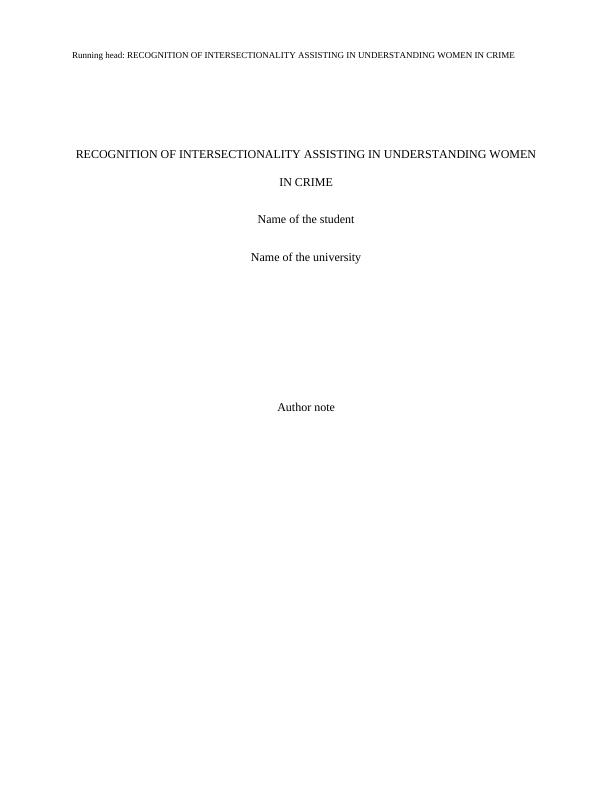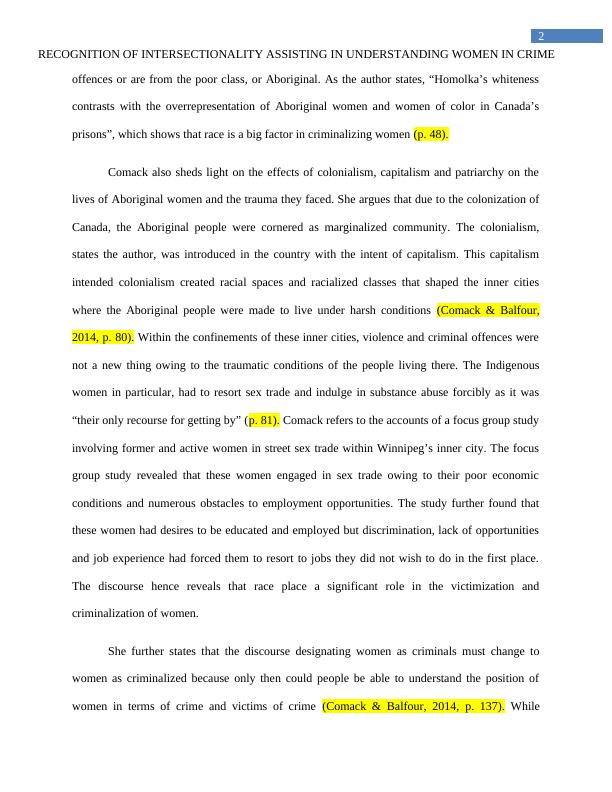Recognition of Intersectionality Assisting in Understanding Women in Crime
Added on 2023-04-22
8 Pages2244 Words72 Views
Running head: RECOGNITION OF INTERSECTIONALITY ASSISTING IN UNDERSTANDING WOMEN IN CRIME
RECOGNITION OF INTERSECTIONALITY ASSISTING IN UNDERSTANDING WOMEN
IN CRIME
Name of the student
Name of the university
Author note
RECOGNITION OF INTERSECTIONALITY ASSISTING IN UNDERSTANDING WOMEN
IN CRIME
Name of the student
Name of the university
Author note

1
RECOGNITION OF INTERSECTIONALITY ASSISTING IN UNDERSTANDING WOMEN IN CRIME
Introduction
The essay aims to provide an understanding of women’s involvement in crime, both their
victimization and criminalization through the recognition of the intersectionality between class,
race, gender inequalities, and ethnicity. The paper will focus on the works of different female
criminologists who have explored the various issues that concern the women population. The
primary source for the discussion is Elizabeth Comack’s Criminalizing Women. The author
clearly states the need to appreciate the “nature and extent of women’s involvement in crime and
the ways in which class, race, gender intersect in the lives of criminalized women” (Comack &
Balfour, 2014, p. 196).
The essay will first provide a brief background of the topic including an explanation of
victimization and criminalization of women. Then, it will attempt to analyze the way recognition
of the interconnection between these and the class, gender and ethnicity of women helps in
understanding their vulnerability in crime.
Discussion
Elizabeth Comack draws attention to the release of Karla Homolka, infamous as
Canada’s “most notorious female offender” in July 2005 to understand the way women criminals
have been portrayed in the media, the law and the academic studies. The author argues that there
is hardly any background study conducted to understand the reasons for women committing
violent crimes. The text clearly identifies the so-called criminal women and their labeling as
dangerous offenders as being the construction of the powerful class against those women who
are marginalized in terms of class and race. Karla Homolka became the center of attraction
because she was an “exception” as most women who break the law are either charged with minor
RECOGNITION OF INTERSECTIONALITY ASSISTING IN UNDERSTANDING WOMEN IN CRIME
Introduction
The essay aims to provide an understanding of women’s involvement in crime, both their
victimization and criminalization through the recognition of the intersectionality between class,
race, gender inequalities, and ethnicity. The paper will focus on the works of different female
criminologists who have explored the various issues that concern the women population. The
primary source for the discussion is Elizabeth Comack’s Criminalizing Women. The author
clearly states the need to appreciate the “nature and extent of women’s involvement in crime and
the ways in which class, race, gender intersect in the lives of criminalized women” (Comack &
Balfour, 2014, p. 196).
The essay will first provide a brief background of the topic including an explanation of
victimization and criminalization of women. Then, it will attempt to analyze the way recognition
of the interconnection between these and the class, gender and ethnicity of women helps in
understanding their vulnerability in crime.
Discussion
Elizabeth Comack draws attention to the release of Karla Homolka, infamous as
Canada’s “most notorious female offender” in July 2005 to understand the way women criminals
have been portrayed in the media, the law and the academic studies. The author argues that there
is hardly any background study conducted to understand the reasons for women committing
violent crimes. The text clearly identifies the so-called criminal women and their labeling as
dangerous offenders as being the construction of the powerful class against those women who
are marginalized in terms of class and race. Karla Homolka became the center of attraction
because she was an “exception” as most women who break the law are either charged with minor

2
RECOGNITION OF INTERSECTIONALITY ASSISTING IN UNDERSTANDING WOMEN IN CRIME
offences or are from the poor class, or Aboriginal. As the author states, “Homolka’s whiteness
contrasts with the overrepresentation of Aboriginal women and women of color in Canada’s
prisons”, which shows that race is a big factor in criminalizing women (p. 48).
Comack also sheds light on the effects of colonialism, capitalism and patriarchy on the
lives of Aboriginal women and the trauma they faced. She argues that due to the colonization of
Canada, the Aboriginal people were cornered as marginalized community. The colonialism,
states the author, was introduced in the country with the intent of capitalism. This capitalism
intended colonialism created racial spaces and racialized classes that shaped the inner cities
where the Aboriginal people were made to live under harsh conditions (Comack & Balfour,
2014, p. 80). Within the confinements of these inner cities, violence and criminal offences were
not a new thing owing to the traumatic conditions of the people living there. The Indigenous
women in particular, had to resort sex trade and indulge in substance abuse forcibly as it was
“their only recourse for getting by” (p. 81). Comack refers to the accounts of a focus group study
involving former and active women in street sex trade within Winnipeg’s inner city. The focus
group study revealed that these women engaged in sex trade owing to their poor economic
conditions and numerous obstacles to employment opportunities. The study further found that
these women had desires to be educated and employed but discrimination, lack of opportunities
and job experience had forced them to resort to jobs they did not wish to do in the first place.
The discourse hence reveals that race place a significant role in the victimization and
criminalization of women.
She further states that the discourse designating women as criminals must change to
women as criminalized because only then could people be able to understand the position of
women in terms of crime and victims of crime (Comack & Balfour, 2014, p. 137). While
RECOGNITION OF INTERSECTIONALITY ASSISTING IN UNDERSTANDING WOMEN IN CRIME
offences or are from the poor class, or Aboriginal. As the author states, “Homolka’s whiteness
contrasts with the overrepresentation of Aboriginal women and women of color in Canada’s
prisons”, which shows that race is a big factor in criminalizing women (p. 48).
Comack also sheds light on the effects of colonialism, capitalism and patriarchy on the
lives of Aboriginal women and the trauma they faced. She argues that due to the colonization of
Canada, the Aboriginal people were cornered as marginalized community. The colonialism,
states the author, was introduced in the country with the intent of capitalism. This capitalism
intended colonialism created racial spaces and racialized classes that shaped the inner cities
where the Aboriginal people were made to live under harsh conditions (Comack & Balfour,
2014, p. 80). Within the confinements of these inner cities, violence and criminal offences were
not a new thing owing to the traumatic conditions of the people living there. The Indigenous
women in particular, had to resort sex trade and indulge in substance abuse forcibly as it was
“their only recourse for getting by” (p. 81). Comack refers to the accounts of a focus group study
involving former and active women in street sex trade within Winnipeg’s inner city. The focus
group study revealed that these women engaged in sex trade owing to their poor economic
conditions and numerous obstacles to employment opportunities. The study further found that
these women had desires to be educated and employed but discrimination, lack of opportunities
and job experience had forced them to resort to jobs they did not wish to do in the first place.
The discourse hence reveals that race place a significant role in the victimization and
criminalization of women.
She further states that the discourse designating women as criminals must change to
women as criminalized because only then could people be able to understand the position of
women in terms of crime and victims of crime (Comack & Balfour, 2014, p. 137). While

End of preview
Want to access all the pages? Upload your documents or become a member.
